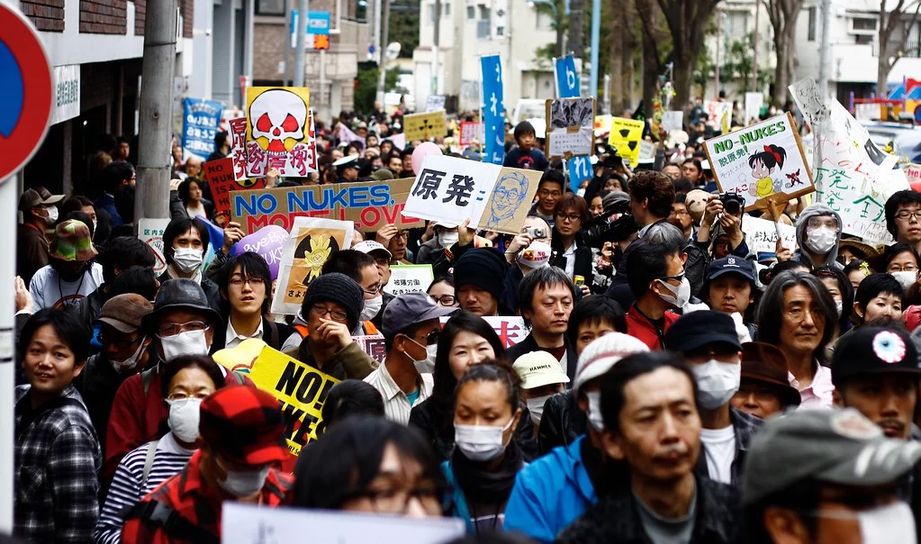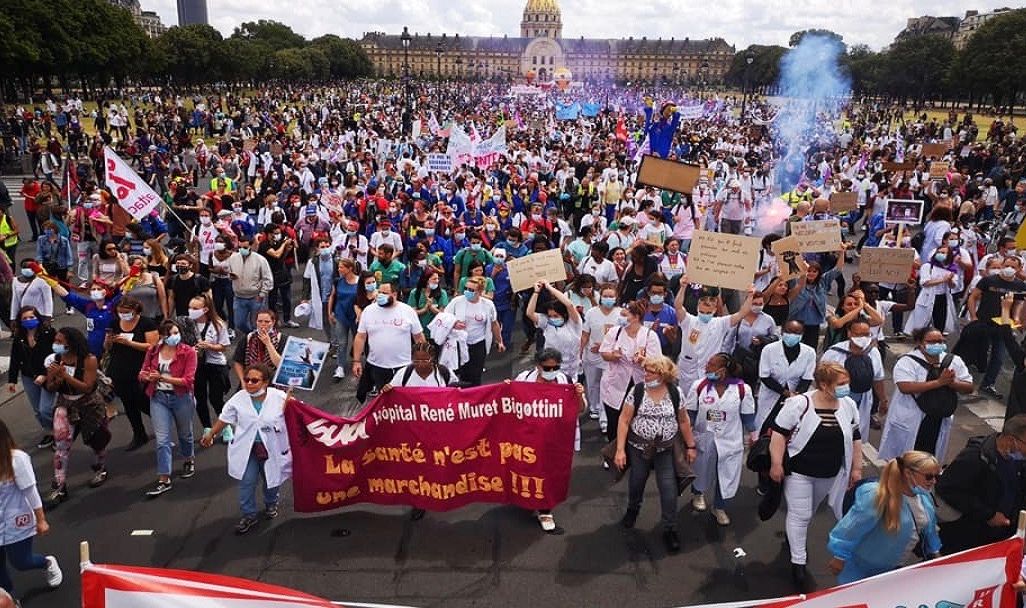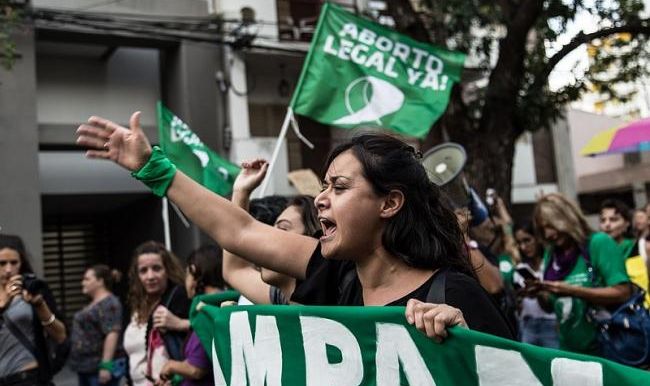James Clement is a member of Socialist Alternative (England, Wales & Scotland).
Genpatsu Iranai, Saikado Hantai! — We Don’t Need Nuclear Power, Oppose the Restarting of the Plants! That’s the call raised by many Japanese workers and youth following the Fukushima nuclear plant disaster 10 years ago on March 11.
Ten years ago this month (March 2021), a magnitude-9 earthquake struck the northeastern Tohoku region of Japan, triggering a tsunami that would in turn cause what is the world’s worst nuclear disaster to date since Chernobyl. The earthquake and tsunami alone caused horrific devastation and loss of life; in just the first few weeks, 15,000 people died, and the earthquake itself was so powerful that it moved Honshu (the largest of the Japanese islands) 2.4 metres eastwards.
No-one can possibly see either the earthquake or tsunami as anything more than freak natural accidents. Yet the resulting Fukushima disaster was a crisis long in the making; a horrific catastrophe just waiting to happen, due to the nuclear industry’s drive for profit over safety.
The fact that a magnitude 7.3 earthquake struck the northeastern region again on February 13, injuring over 150 people (predominantly in Fukushima and Miyagi prefectures) and shutting down a fifth of the country’s crude oil refining operations shows the ever-present danger of such natural disasters to Japan. Including the March 2011 earthquake and the one on February 13 this year, there have been twenty-seven earthquakes of magnitude 5.1 or higher across the country since 2011.
Nuclear power in Japan — the origins
After the sheer devastation of Japan in World War Two, not only from the nuclear bombings of Hiroshima and Nagasaki, but from the many firebombing raids across many major cities such as Tokyo, Kobe, and Yokohama, nuclear power was promoted as vital energy infrastructure. However, the experience of Hiroshima and Nagasaki galvanised a deep resistance to nuclear power amongst ordinary Japanese people; the so-called ‘nuclear allergy’ that from the point of view of the capitalist class, had to be overcome in order to rebuild Japan.
Civil nuclear power was developed following the 1955 Atomic Energy Basic Act, in the international context of US president Eisenhower’s 1953 Atoms for Peace Speech, and as a means of trying to convince the Japanese people, the myth of the nuclear industry’s ‘absolute safety’ was promoted.
According to Sassa Atsuyuki, who was previously Director-General of the Japanese Cabinet of Security Affairs Office and has also worked in the Defence Agency: “As the bombings of Hiroshima and Nagasaki had created a strong aversion to anything nuclear among the Japanese people…Citizens were misled into believing that nuclear power was not at all dangerous, and any dissenting claims were denied.”
This ‘safety myth’ of Japan’s nuclear industry would not be exposed solely by the Fukushima disaster, however; and the Japanese people have suffered cruelly from other horrific industrial disasters due to complete corporate neglect.
Industrial diseases in Japan
In the years following the end of World War Two, Japan has seen what is known as the ‘Big Four’ industrial disasters, causing terrible diseases and health issues for generations of people.
In 1946, the Mitsui Mining Company caused an outbreak of cadmium poisoning in the Jinzu River basin in Toyama Prefecture by dumping waste which polluted the water used for drinking, cooking, and irrigating crops. The result was the so-called Itai-itai Disease, which caused “kidney damage, soft or brittle bones, and…intense shooting pains” (The expression “itai” means “it hurts”). It would only be twenty-two years later that the Japanese government accepted a causal link between the pollution and the disease.
Then in 1956, the Chisso Corporation’s dumping of waste into the river in the Minamata area of Kumamoto Prefecture caused a horrific form of mercury poisoning which came to be known as Minamata Disease. By the end of the year, 54 cases and 17 deaths were confirmed, with symptoms including severe vision problems, loss of sensation and coordination of the hands and feet, and tremors. According to a 2018 study by Hisashi Yokoyama (Mercury Pollution in Minamata), “In severe cases, such patients fall into a state of madness, lose consciousness, and may even die.”
Another variant of Minamata Disease would break out in Niigata Prefecture in 1965, this time as a result of waste dumped into the Agano River by a company called Showa Denko. Again, the Japanese government only acknowledged the link between the pollution and this disease in 1968.
And the last of the ‘big four’ cases began around 1960, in Yokkaichi city in Mie Prefecture. Air pollution from the Yokkaichi petrochemical complex caused “bronchial asthma, chronic bronchitis, emphysema, and other respiratory ailments” and which were known collectively as Yokkaichi Asthma.
These are not issues which only belong in the past, and which have ended. Of the almost 20,000 victims of Minamata Disease who have applied for official recognition, only 3,000 have been recognised, according to a Japan Times article from October 2020.
Japan’s nuclear disasters
Besides the above cases, there is also a history of nuclear disasters in Japan which pre-date Fukushima, showing that it was not an isolated example but a natural result from cutting corners over safety to maximise profit.
In 1995, a fire broke out at the Monju nuclear reactor in the town of Tsuruga; while there were no casualties, there was a cover-up of the damage, and the reactor was decommissioned.
But then in 1999, a radiation leak at the Tokaimura reactor, 70 miles northeast of Tokyo, exposed three workers to the same level of radiation they would get if standing only a mile away from the atomic bomb blast at Hiroshima; that is, radiation levels 4,000 times higher than it is thought a human can safely withstand in a whole year. According to the JCO, who ran the plant, the safety precautions in place meant that there was no need to prepare beforehand for the eventuality of such an accident happening.
This corporate irresponsibility would prove to be a foreshadowing of the disgraceful approach of the Tokyo Electric Power Company (TEPCO) over the safety of the Fukushima plant, in the years running up to the crisis.
TEPCO’s history of neglect
Nine years before the 2011 disaster, TEPCO refused to carry out a simulation to evaluate the effect of a tsunami on the plant, a measure requested by what was then the Nuclear and Industrial Safety Agency (NISA), given that there was a 20% likelihood of a major tsunami hitting the region within 30 years. TEPCO even failed to act on improving safety measures at the plant, despite being aware in 2008 of the possibility of a 15.7 metre-high tsunami wave occurring.
Testimony from TEPCO workers as well as ex-government officials all attest to TEPCO’s sheer irresponsibility, with TEPCO asking one of its subsidiaries to underestimate the scale of the tsunami threat.
Sassa Atsuyuki, mentioned above, pulled no punches when tying the history of the nuclear industry’s shameful neglect with what happened at Fukushima: “The biggest offender was the nuclear industry. If it had learned from past accidents, freed itself from the myth of absolute safety, and taken reasonable countermeasures, the crisis [at Fukushima], caused by the 2011 tsunami, might not have taken place.”
Although the Fukushima disaster meant that nuclear reactors temporarily stopped operations, and there was some reform and deregulation of the monopolies in 2016, there are still huge amounts of profits to be made by the energy utilities in Japan.
Monopolies and profits
In 2018, TEPCO relaunched TV advertising for the first time since the Fukushima disaster, instead of using the money for any further compensation, in a rush to increase the number of gas contracts from 660,000 to one million. The same year, the Kansai region, which alone has an economy almost the size of South Korea, essentially became a ‘battleground’ as the Kansai Electric Power company (KEPCO) and Osaka Gas fought each other for dominance of the regional energy sector.
According to the Japanese government’s basic energy plan from 2018, nuclear power is set to continue providing between 20–22% of energy until 2030. Under the guise of achieving carbon neutrality, nuclear industry bosses are pushing for the restart of nuclear plants, including the TEPCO-run Kashiwazaki-Kariwa plant in Niigata Prefecture (in which Toshiba Energy Systems Corporation now also has a stake.) As well as this, KEPCO has restarted a plant in western Japan, and Kyushu Electric Power Company has resumed operations of the Sendai plant’s No.2 reactor in southwest Japan.
As with all capitalist industry, however, the basis of the profits is the exploitation of the working class. In the case of TEPCO, the Fukushima disaster shone a light on the disgusting use of subcontracted labour and issues over safety and hazard pay.
TEPCO — the scale of exploitation
According to Reuters in 2014, around 30% of the Fukushima plant workers received their pay from a different contractor to the one directing them at their workplace. Before the disaster, in 2009, there were 1,108 regular employees working at the Fukushima No.1 plant compared to 9,195 contract or temporary employees.
Data from the NISA that same year shows the Japanese nuclear industry as a whole hiring more than 80,000 contract workers, compared with 10,000 regular employees. The contracting agencies may even also have links to the Yakuza, with wages and hazard pay siphoned away from the workers themselves; in 2014, four subcontractors sued TEPCO for ¥91.4 million ($868,000) in unpaid hazard pay.
There have also been cases of “trainees” from Vietnam forced into doing cleanup and decontamination work at contaminated areas in Iwate and Fukushima prefectures, areas affected by the 2011 nuclear disaster. Hired by a sub-contractor working for the Tokyo Electric Power Company (TEPCO), which runs the Fukushima plant, they received no training on how to protect themselves from radiation exposure. Given how the trainees borrow huge amounts of money to be able to work in Japan, and so cannot easily leave their jobs once there, it is hardly surprising that the boss of a Tokyo-based contracting firm admitted how vital these workers were.
One Vietnamese trainee, aged 24, was originally supposed to do dismantling and public engineering work — but after arriving in Japan in 2015, he ended up being sent to carry out decontamination work in Koriyama city, Fukushima Prefecture, over a dozen times between October 2015 and March 2016, according to the Zentoitsu Workers Union (based in Tokyo).
He then ended up having to work at dismantling buildings in an exclusion zone in Kawamata town (also in Fukushima Prefecture). This was before the authorities had lifted restrictions on the area that were imposed due to high levels of radiation. For this, he was paid only about ¥140,000 each month (£944.96) — three times less than a Japanese worker doing the same job.
Contractors have also robbed other Vietnamese trainees of their own hazard pay; around ¥1.6 million was siphoned off three trainees in 2018.
Ten years on — the suffering continues
Even today, the situation remains dire for those who were displaced after having to evacuate the areas; their free temporary housing provision ended in 2016, and the prospect of increased rents due to the end of financial support from the government has pushed up the suicide rates in the affected areas. Since 2015, the male suicide rate in Fukushima Prefecture has been above the national average.
Another major issue that has been ongoing since the disaster has been the struggle over compensation for the victims, both from the Japanese state and TEPCO itself. While there have been certain victories from lawsuits brought through the courts, over compensation payments as well as rulings of liability, this is often a contradictory process. A ruling which found that the state was not liable for the accident and therefore absolved of the need to pay compensation, overturned the previous ruling from the Maebashi District Court. However, the most recent ruling by the Tokyo High Court finds the state liable, and must (along with TEPCO) pay $2.7 million in compensation to 43 people.
The class dimension of the nuclear power issue in Japan goes hand-in-hand with the context of the history of disasters, and since 2011 the anti-nuclear movement has been a major facet of protests and struggles across the country.
The anti-nuclear movement
In the months following the 2011 disaster, mass protests against nuclear power exploded across Japan, and have continued in years since. In September that year, a huge demonstration in Tokyo (involving 20,000 people according to the police, although media reports instead put the number at 60,000) was back then the largest demonstration not just since the disaster itself, but even in recent years in Japan. In 2012, around 200,000 people organised under the Metropolitan Coalition Against Nukes held a demonstration outside the Prime Minister’s office building, and large-scale protests against nuclear power have even involved many nuclear industry workers themselves.
One of the popular rhyming Japanese slogans from immediately after the disaster is “Genpatsu Iranai, Saikado Hantai!”This essentially translates to “We Don’t Need Nuclear Power, Oppose the Restarting of the Plants!” and goes together with slogans such as “Sayonara Genpatsu”(“Goodbye to Nuclear Power”).
The protestors do not simply call for increased safety measures or tighter regulations; they call for the complete end to the use of nuclear power in Japan. The strength of public feeling, shown through mass (yet disparate) protests across the country in the years since 2011, is reflected in the demands of trade union federations and ‘civil society’ groups for ’zero nuclear power’ and opposition to the restarting of nuclear plants. And at least on the surface, there appears to have been a ‘qualitative shift’ in Japanese politics as different parties now stand on an anti-nuclear platform. However, the seemingly anti-nuclear stance of right-wing figures such as Yuriko Koike and Shinjiro Koizumi would ultimately bring them into conflict with the interests of big business and so cannot be assumed to be entirely genuine. The ruling Liberal Democratic Party, and Keidanren (the Japan Business Federation) both remain wedded to support of the nuclear industry, also under the guise of eventually achieving carbon neutrality.
In Japan, there are three different trade union federations instead of just one; the largest (and more conservative) is Rengo, while the others are Zenroren (aligned with the Japan Communist Party) and Zenrokyo (more supportive of the Social Democratic Party and the New Socialist Party). A piece posted on the Zenroren website last December highlighted the demands for the scrapping of all nuclear power, and the immediate implementation of a ‘Zero-Nuclear Power Basic Energy Law’ providing for the use of renewable energy instead. The fairly recent left-populist party, Reiwa Shinsengumi (led by TV personality and activist Taro Yamamoto) poses an explicitly anti-nuclear platform, calling for an immediate ban on nuclear power plants and 100% reliance on renewable natural energy.
A way forward for the Japanese working class
The anti-nuclear movement is a clear pole of attraction for Japanese workers and youth who are becoming increasingly radicalised by the material conditions of life under capitalism, and who often take a much more progressive stance on issues such as LGBTQ+ rights than the ruling elite and the establishment. Yet the problem is that the individual large protests across Japan, not just against nuclear power but over constitutional revision, the security laws, and in opposition to the scandals of the previous Abe government have not taken on the character of a sustained, mass movement against the very capitalist system in Japan or globally. And as well as this, is the lack of a revolutionary mass workers’ party pointing the way forward.
Back in 2008, in the midst of an economic crisis, the Japan Communist Party saw large increases in its youth membership, yet it fails to offer a way forward that would mean a decisive break with capitalism. Instead, its program talks about “Advancing toward socialism through a market economy”.
Currently, Reiwa Shinsengumi is also gaining in popularity amongst people searching for an alternative, yet while it stands on a platform of positive left-reformist policies such as a national ¥1500 minimum wage, wiping out all debt from student loans, and scrapping the Consumption Tax. Besides winning two seats in parliament during the 2019 election, (although Yamamoto failed to win his seat), Reiwa Shinsengumi claims that it has received over ¥400 million ($3.7 million) in donations from around 30,000 people.
Clearly under capitalism, nuclear power is a constant threat to the lives of working-class people, with safety sacrificed for profit. We echo the demand to scrap nuclear power in Japan, and call for an end to all subcontracting in the energy industries. All workers should be re-trained and given permanent, secure work in the renewable energy sector, with full trade union rights, pay and conditions. There should be equal rights and conditions for migrant workers in Japan; scrap the exploitative ‘trainee’ system and provide permanent, secure jobs!
All big business, including the energy utilities, should be immediately brought under democratic public ownership, with workers’ control and management. For increased compensation, negotiated by workers’ committees and not the bosses or their representatives in government, to be paid out to all survivors and their families. For the provision of free, high-quality public housing for all survivors, with full financial support.
Socialists looking to point the way forward for the Japanese working class, need to engage with the layers of people now seeking an alternative, or who are drawn into single-issue movements. We should argue that left groups like Reiwa Shinsengumi and other ‘civil society’ organisations actively push for trade union endorsements, to transform them from being more individual, disparate, or ‘celebrity-led’ groups into a coherent mass movement on a platform of socialist programmatic demands. There should be a linking up of all the issues around which the Japanese working class and youth have entered into even mild levels of struggle, such as climate change, refugees, migrants, and LGBTQ+ peoples’ rights, with the trade union struggles over precarious and insecure work, low pay, and working conditions. All of these should be tied to the fundamental nature of the capitalist system on a global scale; there should also be active solidarity with the masses of Asia, and the movements in China, Hong Kong, India, Thailand and Indonesia.
Ultimately, what is needed is a fight against global capitalism, under which poverty, exploitation, oppression and disaster are part and parcel of millions of peoples’ lives worldwide. We need to fight for a socialist society — a world where production is planned and controlled by working class people according to their needs, not the profits of big business. A world where all oppression and discrimination is a thing of the past.




